Modern Furniture - Table of contents
Miscellany - CooCooU27 Furniture Showroom
111 Tonawanda St., Buffalo, NY
CooCooU 27 - Official website
(online Jan. 2017)
On this page, below:
Milo Baughman - Burl Dining Table
Milo Baughman - Armchairs
Edward Wormley - Button-Tufted "Party Sofa"
Edward Wormley - "Sheaf of Wheat" Side Table
Marcel Breuer - Tubular Steel desk
Jens Risom - DeskFlorence Knoll - Black Lacquer and Grasscloth Credenza
|
CooCooU
CooCooU, Buffalo’s leading retailer in Mid Century Modern furniture and decor, closed its Chandler Street location. Owner Michael Merisola set out looking for a space that would suit his needs. Today, CooCooU Modern can be found at 111 Tonawanda Street (2nd floor). Merisola has a discerning eye for tracking authentic Mid Century finds, as well as an uncanny knowhow when it comes to deciphering what it is that he is looking at. He has spent most of his life hunting down hard to find chairs, tables, lights, artwork and any other significant turn of the century furnishings. In fact, Michael began collecting when most people thought that pieces from the era were still garbage. Today Merisola is respected all over the country for his expertise on the subject. As Mid Century decor has come back into style, CooCooU has been the driving force behind the movement in Buffalo. - Queenseyes, "CooCooU Counters with a Swift Move." Buffalo Rising, Jan. 22, 2017 |
| Entering CooCooU27
(formerly CooCooU) is kind of like walking into a museum: 20th century
artifacts are frozen in time and on display. Traverse the multi-level
warehouse and you may find an old-fashioned phone booth or a Frank Lloyd Wright windowpane, an antique guitar, unusual sculpture, or a one-of-a-kind industrial light fixture. “I consider myself an urban archaeologist,” said owner Michael Merisola. He’s been collecting and selling for over 30 years. Merisola’s 30,000 square foot location houses an eclectic collection of mid-century modern pieces ranging from artwork and architectural to industrial and decorative. “Vintage instruments, pottery, glassware, china, sculpture, paintings… it’s not just furniture,” said Merisola, who works primarily with estates and dealers (but will work with anyone who has mid-century pieces to sell). “I’m out every day, searching, following leads.” “Most of the furniture made today, you’ll be hard-pressed to see it last for very long,” said Merisola. “The pieces I find are beautiful and have completely maintained their structural integrity. When it comes to quality and design, there’s nothing like it.” - Erin Morris, "Best of 716: Furniture redux" on The Buffalo News, July 27 (online Feb. 2017) |
Showroom 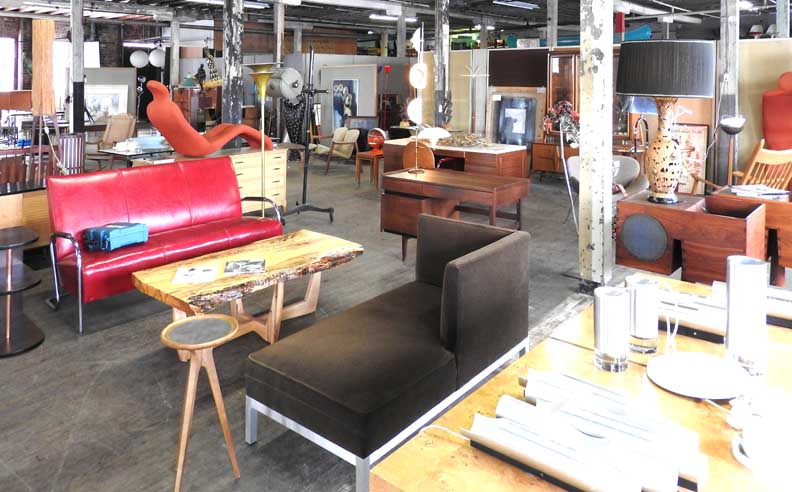 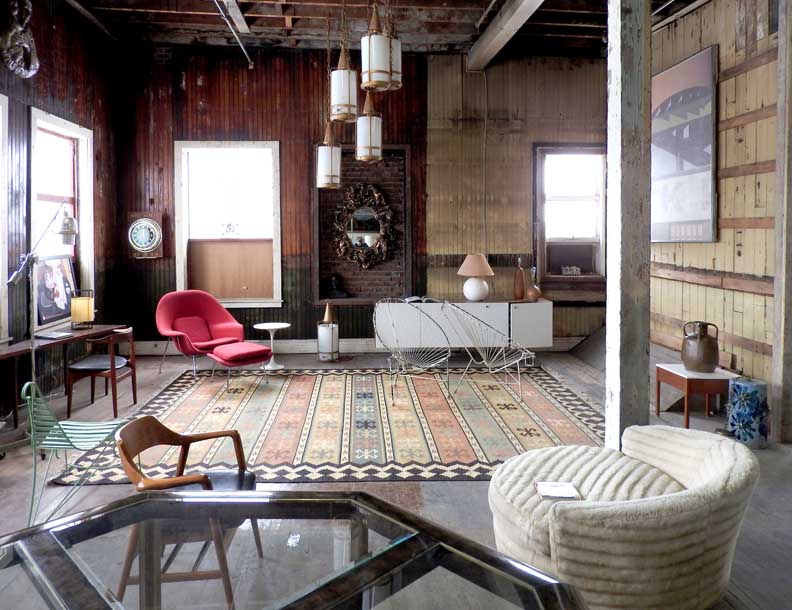 |
Milo Baughman Burl Dining Table 1970s, 2 Leaves 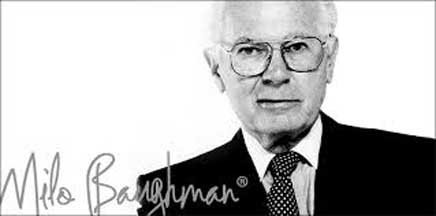 Source: McElheran's (online Feb. 2017)  Left table: Milo Baughman 1970s Burl Dining Table 2 Leaves ... White armchairs: Milo Baughman ... Sofa: Edward Wormley "American designer Milo Baughman is known for his avant-garde yet
unassuming and affordable designs. He designed for a number of
furniture companies starting in the 1940s, he is most famous for the
designs made for the manufacturer Thayer Coggin. He also lectured on
modern design, extolling the positive benefits of good design on the
lives of human beings. Defining Features:
Baughman believe
furniture should be attainable and affordable. He once said that
'furniture that is too obviously designed is very interesting, but too
often belongs only in museums.' Yet his designs have that sense of
Hollywood glamour, and sexy, clean shapes." - Lucia Tolosa, "The
Mid-Century Furniture Designers You Need To Know," The Highboy, July 20, 2016
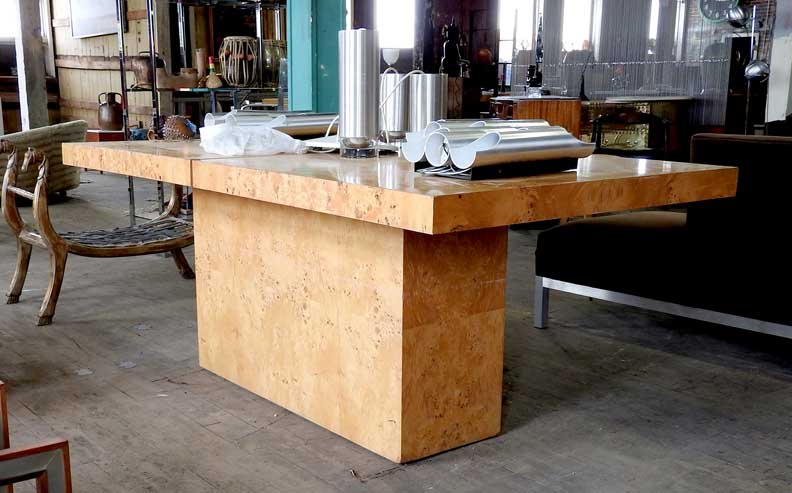 Milo Baughman 1970s Burl Dining Table 2 Leaves ... The sides open together automatically and in the base is space for the leaves to sit in. 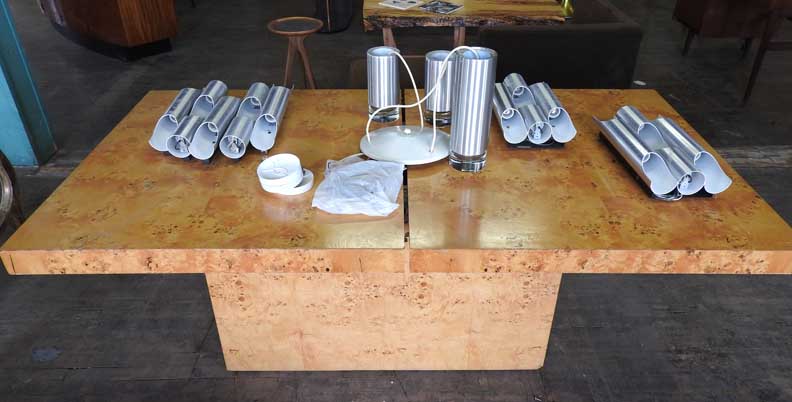 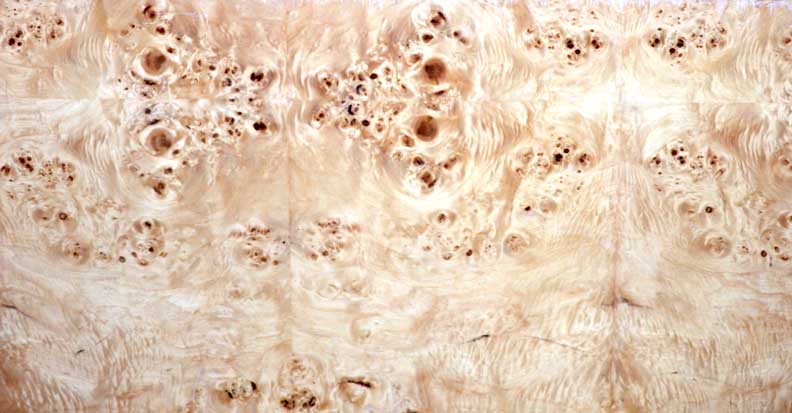 Milo Baughman ... Burl olive wood |
Milo Baughman Pair of Chrome and Upholstered Armchairs 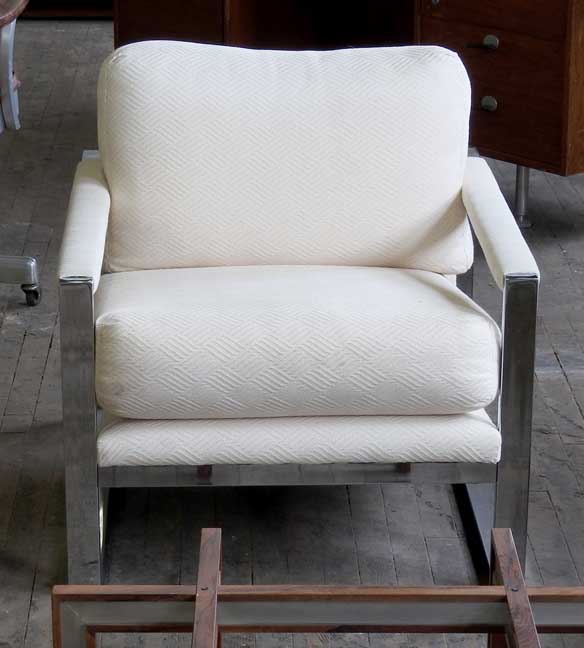 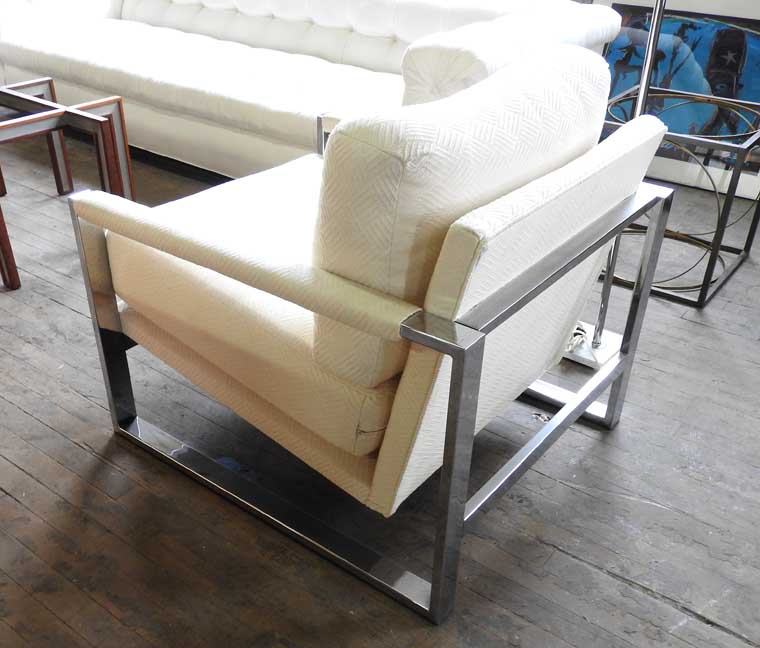 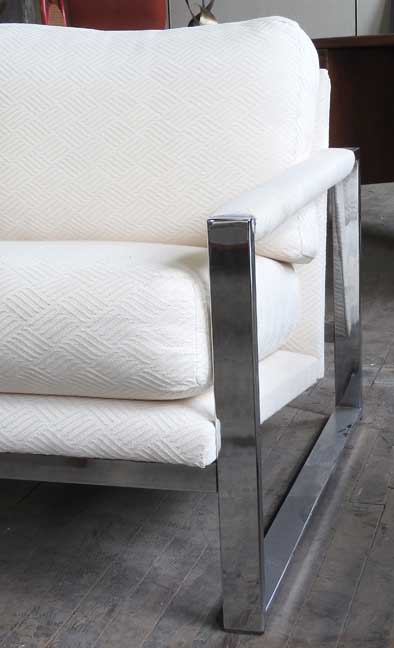 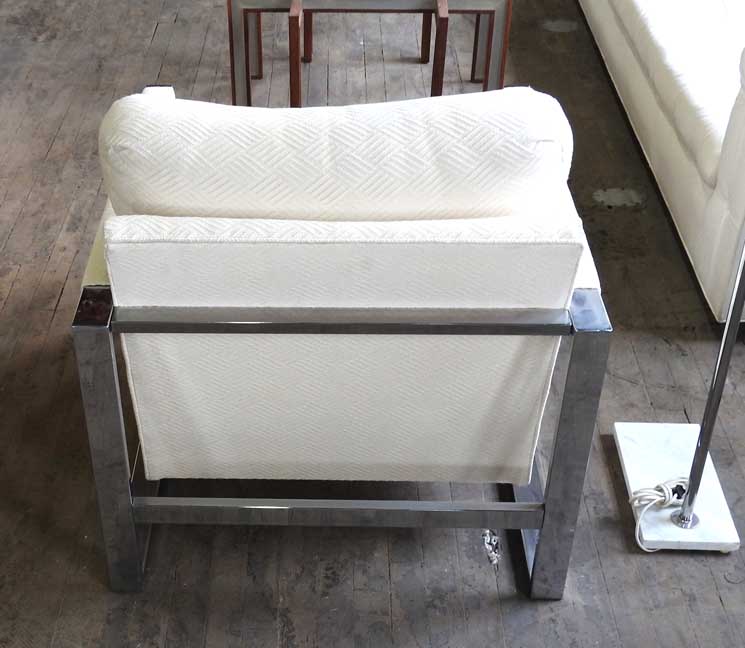 |
|
"As the longtime director of design for the Dunbar furniture company, Edward Wormley was, along with such peers as George Nelson at Herman Miller Inc., and Florence Knoll of Knoll Inc.,
one of the leading forces in bringing modern design into American homes
in the mid 20th century. Not an axiomatic modernist, Wormley deeply
appreciated traditional design, and consequently his work has an
understated warmth and a timeless quality that sets it apart from other
furnishings of the era.
"Wormley was born in rural Illinois and as a teenager took correspondence courses from the New York School of Interior Design. He later attended the Art Institute of Chicago but ran out of money for tuition before he could graduate. Marshall Field hired Wormley in 1930 to design a line of reproduction 18th-century English furniture; the following year he was hired by the Indiana-based Dunbar, where he quickly distinguished himself. It was a good match. Dunbar was an unusual firm: it did not use automated production systems; its pieces were mostly hand-constructed. For his part, Wormley did not use metal as a major component of furniture; he liked craft elements such as caned seatbacks, tambour drawers, or the woven-wood cabinet fronts seen on his Model 5666 sideboard of 1956. He designed two lines for Dunbar each year - one traditional, one modern - until 1944, by which time the contemporary pieces had become the clear best sellers. "Many of Wormley’s signature pieces are modern interpretations of traditional forms. His 1946 Riemerschmid Chair - an example is in the collection of the Museum of Modern Art - recapitulates a late 19th-century German design. The long, slender finials of his Model 5580 dining chairs are based on those of Louis XVI chairs; his Listen-to-Me Chaise (1948) has a gentle Rococo curve; the “Precedent” line that Wormley designed for Drexel Furniture in 1947 is a simplified, pared-down take on muscular Georgian furniture. But he could invent new forms, as his Magazine Table of 1953, with its bent wood pockets, and his tiered Magazine Tree (1947)... " - 1stDibs (online Feb. 2017) 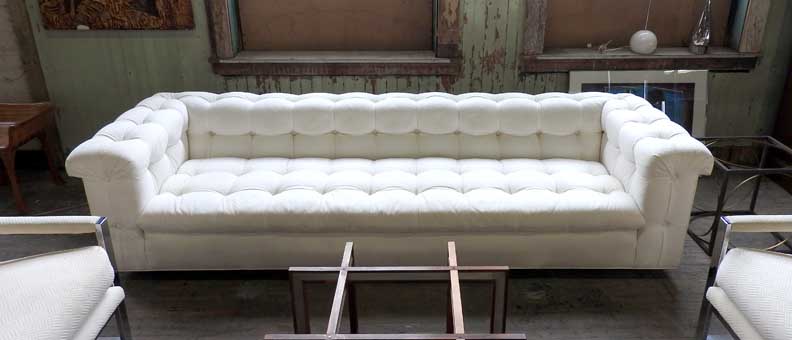 Iconic Wormley "Party" sofa for Dunbar. Wormley's take on the classic Chesterfield sofa with rolled arms and biscuit tufting. Reupholstered (within the past 5 years) in a winter white fabric. Sofa on recessed castors. 24 in.Hx102 in.Wx36 in.D On Feb. 3, 2017 for sale at $9,800 on 1stdibs. Dealer: CooCooU.
 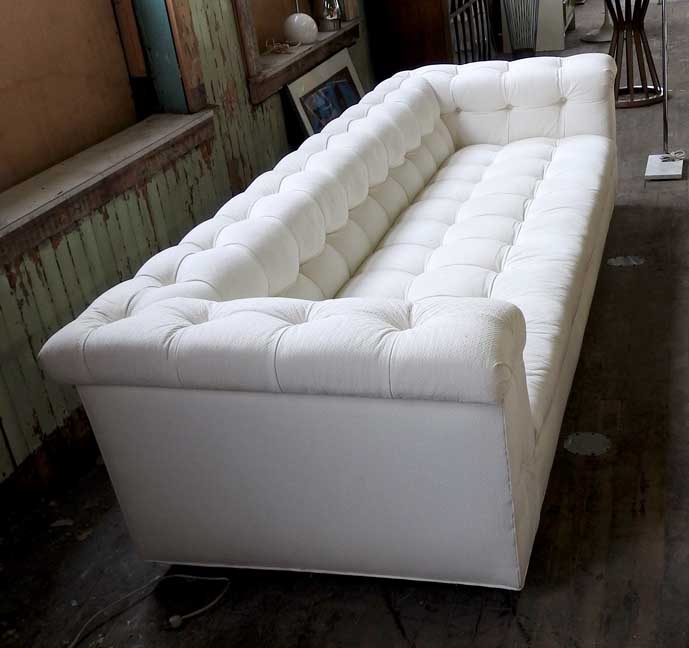 |
Edward Wormley "Sheaf of Wheat" Side Table for Dunbar, C. 1960 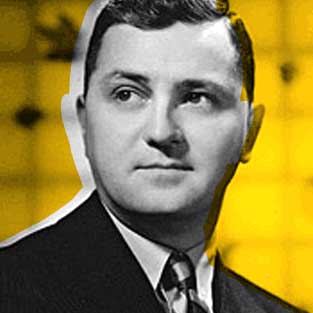 Source: Mid2Mod (online Feb. 2017) "Edward Wormley began with Marshall Fields as an interior designer. But he established his true potential with manufacturer Dunbar Furniture The Highboy, July 20, 2016 Co. when he was hired to update the brand’s product line. European and Scandinavian details blended with elements of classical, historical designs with the modern leanings of the day" - Lucia Tolosa, "The Mid-Century Furniture Designers You Need To Know," The Highboy, July 20, 2016 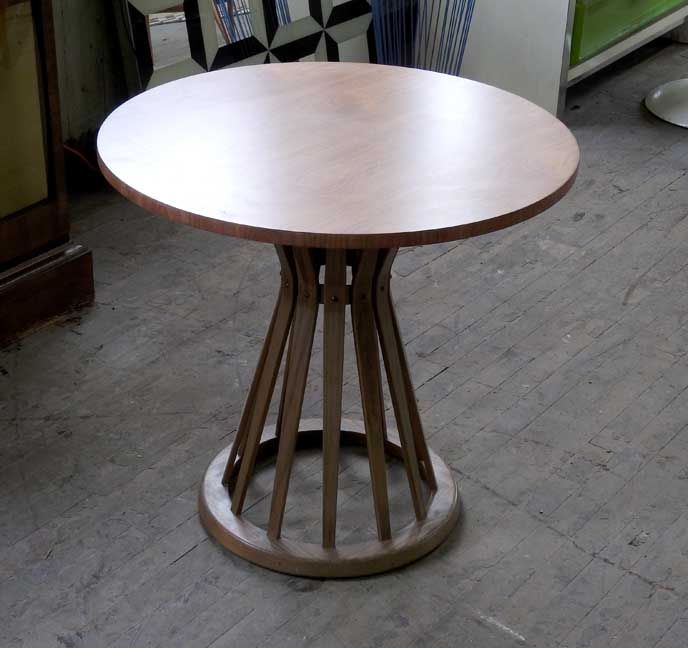 Table top detailed below:  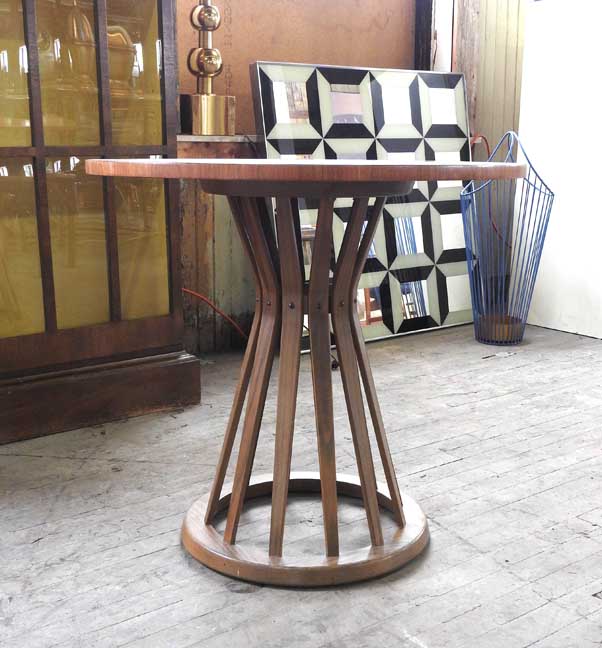 Legs detail below: 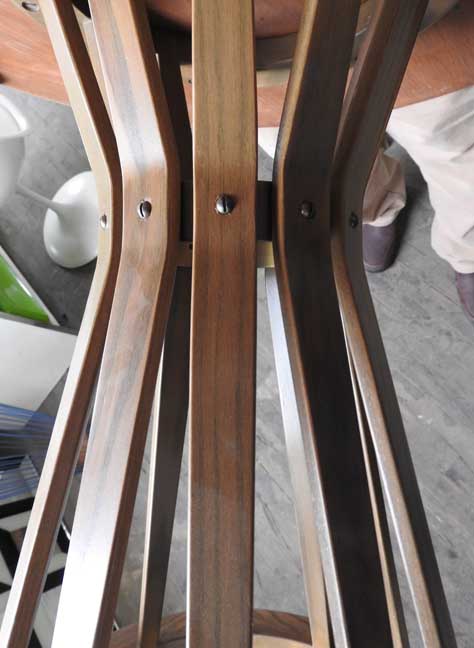  Found under the table top |
"When Hungarian-born designer and architect Marcel Breuer left
Europe in the ‘30s to teach architecture at Harvard and start his own
practice, it served as a catalyst for the spread of Modernist design.
Breuer was educated at the Bauhaus, where he created a series of
influential new furniture pieces and became a protege of Walter
Gropius. The steel “Wassily Chair,” a radical take on the club chair,
still looks futuristic nearly a century later." - Lucia Tolosa, "The Mid-Century Furniture Designers You Need To Know," The Highboy, July 20, 2016 On Feb. 3, 2017, for sale online at 1stdibs for $9,800, plus shipping ... 1stdibs dealer since 2014: CooCooU "Designed by the Bauhaus architect Marcel Breuer in 1935, this desk shows very well the functional Design of the Bauhaus School. The desk in ash with visible wood texture was produced by Thonet in the 1930s. Seldom seen version. Early example, nickel connectors, grommets fastening top. Retains original pull-out work surface, stunning desk 30" H, lower tier 25" H." - 1stDibs 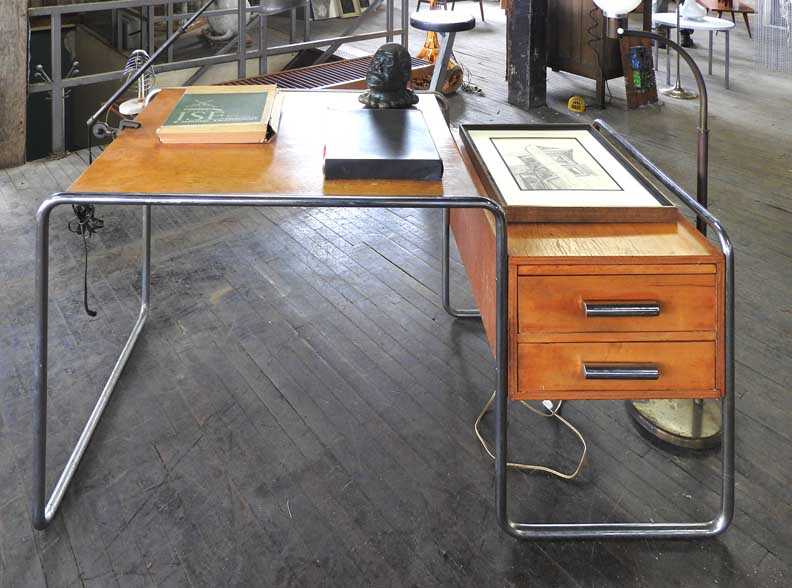  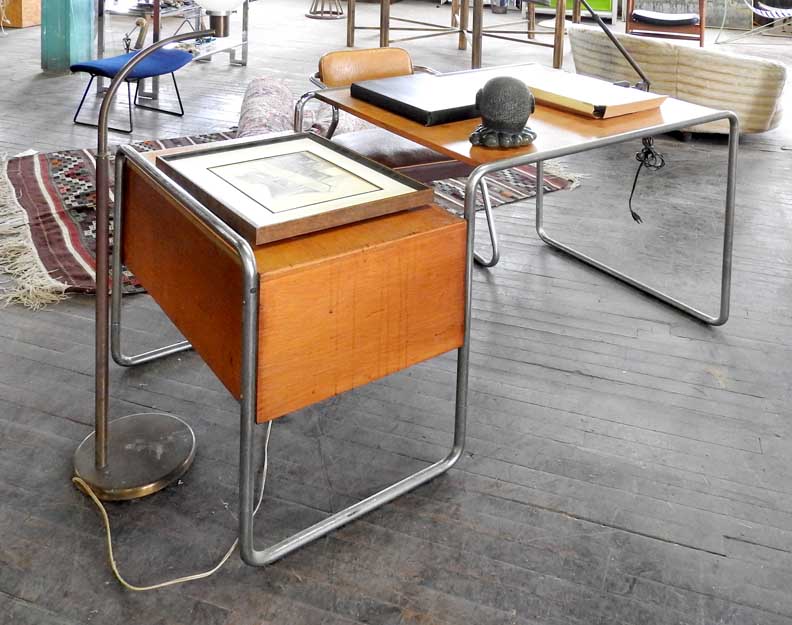 |
"Along with Hans Wegner, Arne Jacobsen and BÝrge Mogensen, Finn Juhl was one of the great masters of mid-20th-century Danish design. Juhl was the first among that group to have his work promoted overseas, bringing the character of the nation’s furnishings - and the inherent principles of grace, craftsmanship and utility on which they were based - to an international audience. A stylistic maverick, Juhl embraced expressive, free-flowing shapes in chair and sofa designs much earlier than his colleagues, yet even his quietest pieces incorporate supple, curving forms that are at once elegant and ergonomic. "As a young man, Juhl hoped to become an art historian, but his father steered him into a more practical course of study in architecture. He began designing furniture in the late 1930s, a discipline in which, despite his education, Juhl was self-taught, and quite proud of the fact. His earliest works, designed in the late 1930s, are perhaps his most idiosyncratic. "The influence of contemporary art is clear in Juhl's 1939 “Pelican” chair: an almost Surrealist take on the classic wing chair. Critics reviled the piece, however; one said it looked like a "tired walrus." Juhl had tempered his creativity by 1945, when the Danish furniture-making firm Niels Vodder began to issue his designs. Yet his now-classic “NV 45” armchair still demonstrates panache, with a seat that floats above the chair’s teak frame. "Juhl first exhibited his work in the United States in 1950, championed by Edgar Kaufmann Jr., an influential design critic and scion of America’s most prominent family of modern architecture and design patrons. (Kaufmann’s father commissioned Frank Lloyd Wright’s design of the house “Fallingwater.”) "Finn Juhl’s furniture - as well as his lighting, ceramics, tableware and accessories - has an air of relaxed sophistication and elegance that is unique in the realm of mid-20th- century design." - "Finn Juhl Furniture," 1stdibs (online Jan. 2017) 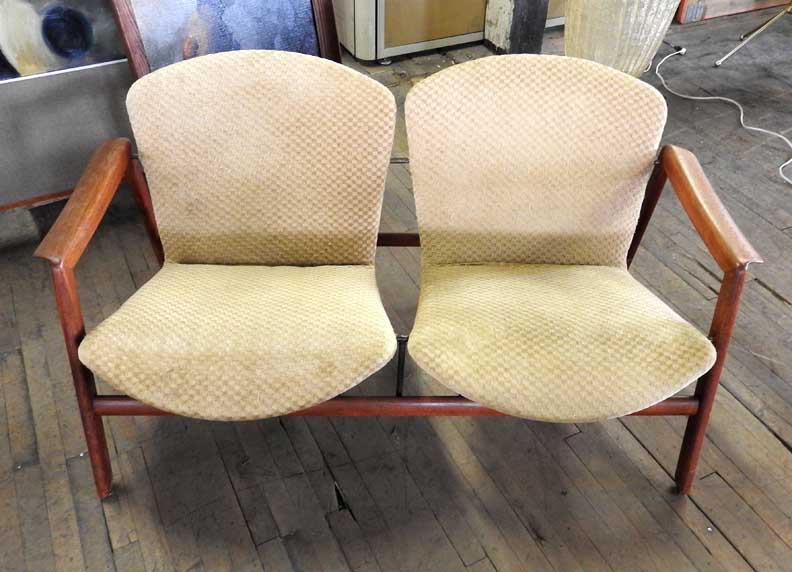 Finn Juhl love seat   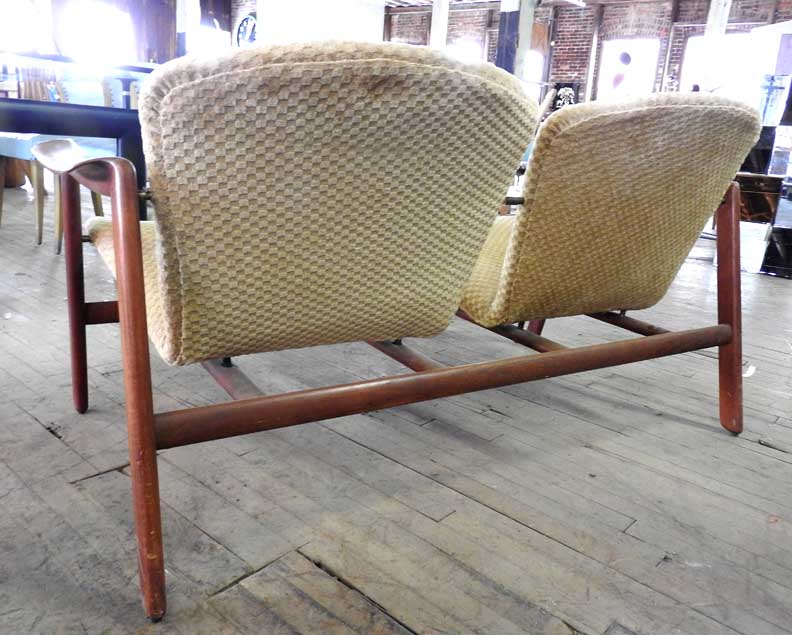 In 2000, Onecollection acquired the exclusive rights to produce Finn Juhl’s iconic furniture from the 1940’s and 50’s. Since then, the company has re-launched a comprehensive range of Juhl’s designs. In 2013, Onecollection manufactured all new furniture for the Finn Juhl Chamber at the UN Headquarters in New York. |
|
"The Danish-born Jens Risom brought the Scandinavian design sensibility to a wide audience in the United States. As the first designer for Knoll Inc., Risom introduced American buyers to the region’s enduring design values of simplicity, grace and craftsmanship. "Risom trained in furniture making at the Copenhagen School of Industrial Arts and Design under Ole Wanscher, alongside classmates Hans Wegner and Borge Mogensen. In 1939, a year after graduating from business school, Risom decided to move to the U.S. "While working for an interior designer in New York in 1941, he met Hans Knoll, and the businessman and the designer hit it off. They brought out their first line the next year, despite wartime materials restrictions. "Risom was drafted into the army, and served as a translator under General George Patton. "When he returned from the war, Risom clashed over furniture design ideals with his business partner’s new bride, Florence Knoll, who was schooled in the Bauhaus method, which favored furniture with strict, geometric metal frames. Risom then started his own company, Jens Risom Design. "In the course of his long career, Risom developed a stylistic vocabulary that was a reflection of the life of the man himself: his furniture has Danish warmth coupled with an American air of crisp efficiency. A Risom chair is almost instantly recognizable - the arms and seat backs are set at a distinctive angle that seems to invite people to sit back and relax, yet they know they can hop up in an instant, ready to go." - "Jens Risom Furniture," 1stdibs (online Jan. 2017) 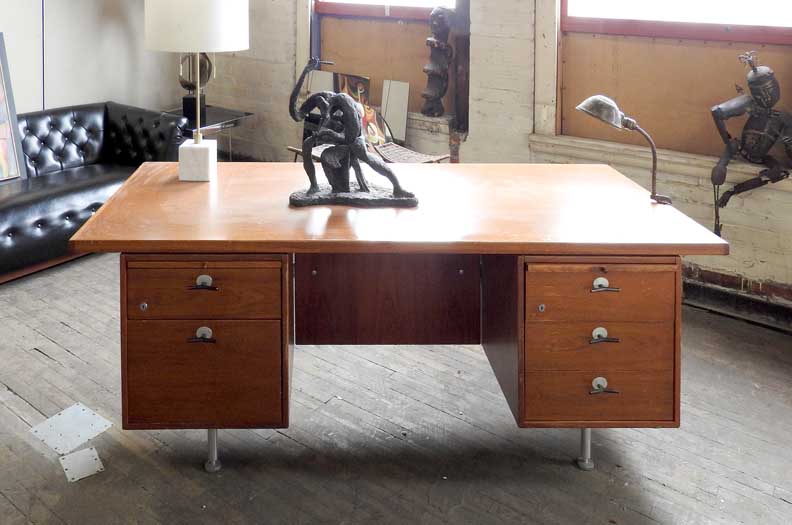    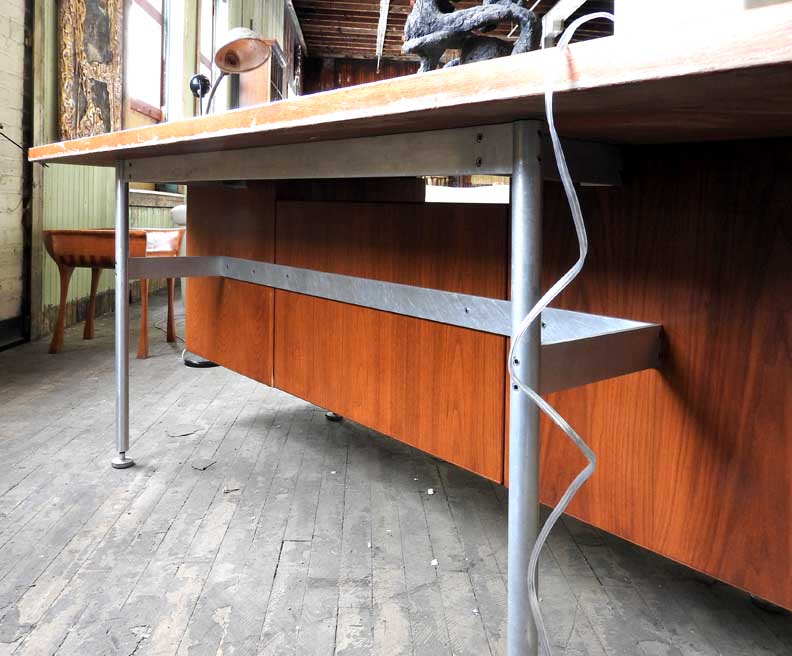 |
|
"Architect, furniture designer, interior designer, entrepreneur - Florence Knoll had a subtle but profound influence on the course of mid-century American modernism. Dedicated to functionality and organization, and never flamboyant, Knoll shaped the ethos of the post-war business world with her polished, efficient design and skillfully realized office plans. "Knoll had perhaps the most thorough design education of any of her peers. Florence Schust was orphaned at age 12, and her guardian sent her to Kingswood, a girl’s boarding school that is part of the Cranbrook Educational Community in suburban Detroit. Her interest in design brought her to the attention of Eliel Saarinen, the Finnish architect and head of the Cranbrook Academy of Art. Saarinen and his wife took the talented child under their wing, and she became close to their son, the future architect Eero Saarinen. While a student at the Academy, Florence befriended artist-designer Harry Bertoia and Charles and Ray Eames. Later, she studied under three of the Bauhaus masters who emigrated to the United States. She worked as an apprentice in the Boston architectural offices of Walter Gropius and Marcel Breuer; Ludwig Mies van der Rohe taught her at the Illinois Institute of Technology. "In 1941, she met Hans Knoll, whose eponymous furniture company was just getting off the ground. They married in 1946, and her design sense and his business skills soon made Knoll Inc. a leading firm in its field. Florence signed up the younger Saarinen as a designer, and would develop pieces by Bertoia, Mies and the artist Isamu Noguchi. Her main work came as head of the Knoll Planning Group, designing custom office interiors for clients such as IBM and CBS. The furniture Florence created for these spaces reflects her Bauhaus training: the pieces are pure functional design, exactingly built; their only ornament from the materials, such as wood and marble. Her innovations - the oval conference table, for example, conceived as a way to ensure clear sightlines among all seated at a meeting - were always in the service of practicality." - 1stDibs (online Feb. 2017) 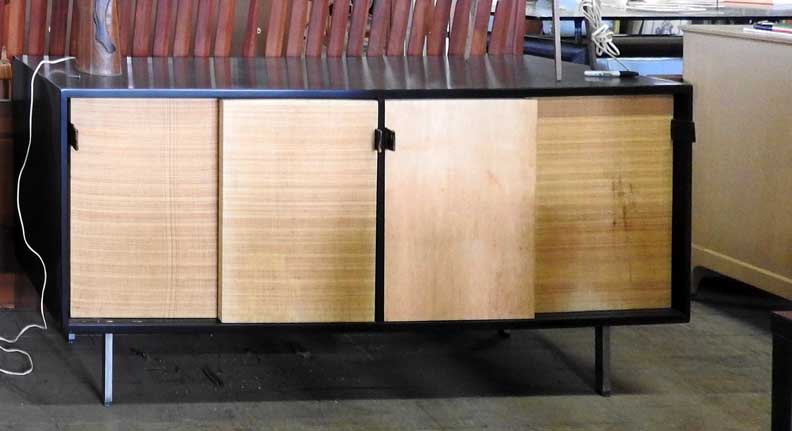 Early leather strapped pulls ... Lacquered wood ... Chrome legs ... Four sliding doors ... File drawer ... 2 ,shelves ... 4 drawers 27.5 in.Hx72 in.Wx18 in.D On Feb. 4, 2017, for sale for $5,900 at 1stDibs. Dealer: CooCooU 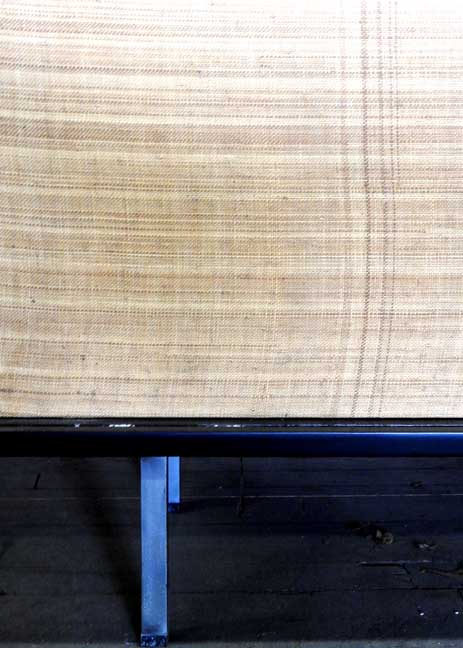 Grasscloth 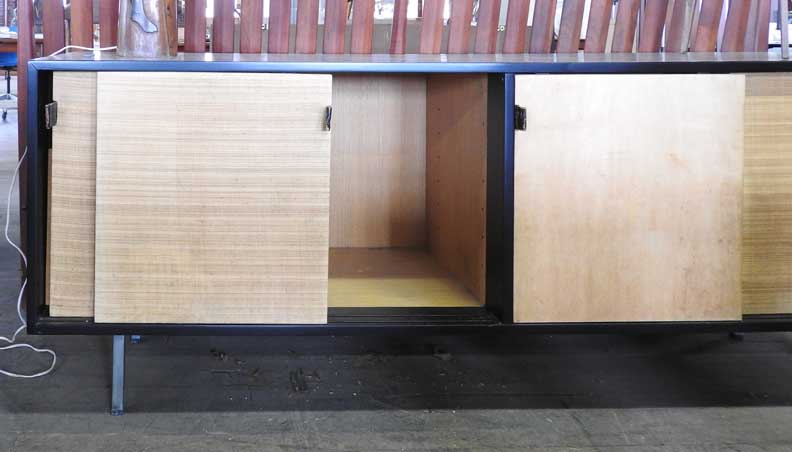 Sliding doors |
Florence Knoll Table for Knoll Manufacturing "In creating the revolutionary Knoll Planning
Unit, Florence Knoll defined the standard for the modern corporate
interiors of post-war America. Drawing on her background in
architecture, she introduced modern notions of efficiency, space
planning, and comprehensive design to office planning. Florence
ardently maintained that she did not merely decorate space. She created
it. The Planning Unit rigorously researched and surveyed each client —
assessing their needs, defining patterns of use and understanding
company hierarchies — before presenting a comprehensive design,
informed by the principles of modernism and beautifully executed in
signature Knoll style. Florence and the Planning Unit were responsible
for the interiors of some of America’s largest corporations, including
IBM, GM and CBS." - Knoll (online Feb. 2017)
 Photo source: Knoll (online Feb. 2017)   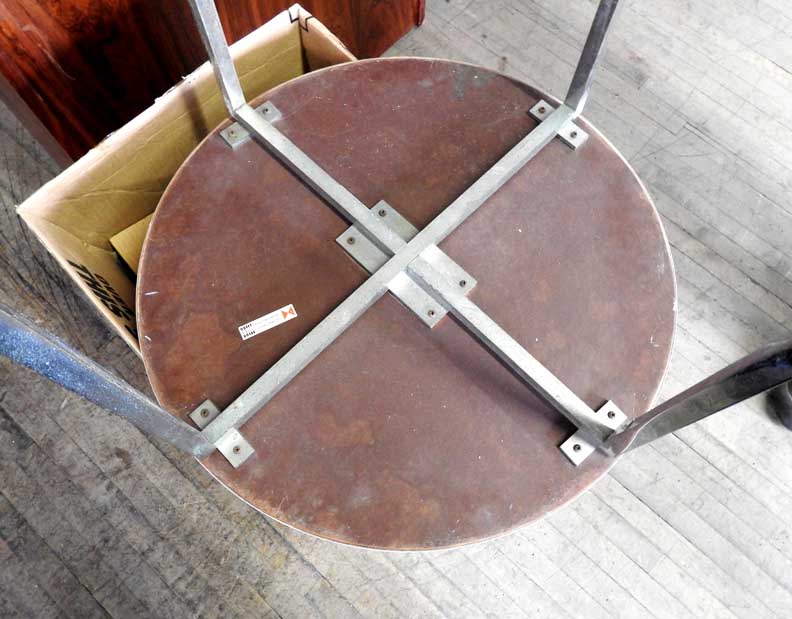 Note the Knoll label under the table top |
Gilbert Rohde Burl Wood Credenza
Gilbert Rohde was one of the pioneers of American Modern design.
Starting in the late 1920's, Rohde designed furniture for clients and
his own furniture retailed by others. In 1930 he designed a line of
furniture for Heywood Wakefield and beginning in 1930 until 1944 he
designed for Herman Miller Company, using a variety of new materials
and techniques. While Rohde designed for several other furniture
manufacturers his work for Herman Miller remains his best work and some
of the best work of the period. Rohde's designs for clocks for the
Herman Miller Company and lamps for the Mutual Sunset Lamp Company are
classics of the Art Deco era." - "Gilbert Rohde," Modernism Gallery (online Jan. 2017)"Rohde ... was born Gustav Rohde in the Bronx in 1894. His parents, Max and Mathilde Rohde, belonged to the thriving community of recent German immigrants in Washington Heights. Young Gus, as he was known, managed to gain admittance to the elite Stuyvesant High School in Manhattan, where his classmates included future New Yorker critic Lewis Mumford. He showed some talent for graphic design in his early years, taking classes at the Art Students League and the Grand Central School of Art and working as a freelance commercial artist for Abraham & Straus, Macy’s, W. & J. Sloane, and other stores. "In the summer of 1927, Rohde, who had now changed his name to Gilbert (in an apparent effort to distance himself from his German origins), traveled to Europe. He made stops in London and Paris before going on to Germany, where he visited the Bauhaus in Dessau - one of the first Americans to do so. The journey seems to have strengthened his resolve to begin making modern furniture, and by 1929 his designs, including a room at the 'Modern American Design in Metal' exhibition at the Newark Museum, had started to attract notice. "He shunned the more outlandish experiments of the European modernists, opting instead for intentionally simple designs, which Rohde thought would fit more easily with other styles of furniture. The result was a modernism of accommodation - one contrived precisely to appeal to middle-class sensibilities and middle-class budgets. "... he reconceived the way in which furnishings could be matched and grouped. Already with his work for Heywood-Wakefield, Rohde had begun to display a strong interest in coordinated groups of furnishings and modularity. Instead of fixed suites of furniture, he advocated coordinated systems or lines, which allowed his manufacturing clients to offer new collections each season. "Herman Miller’s efforts to encourage the loyalty of customers also relied on designer branding. Rohde was among the first American designers to have his furniture marketed under his name. Both Heywood-Wakefield and Herman Miller featured Rohde’s name prominently in their advertising, as did a number of the companies he worked for in his later years. "By the end of the 1930s, Rohde was probably the best known of the American modernist furniture designers. His work for Herman Miller enjoyed surprising popularity..." - EXCERPTS: Christopher Long, "Gilbert Rohde: Modern Design for Modern Living" on Chipstone (online Feb. 2017) 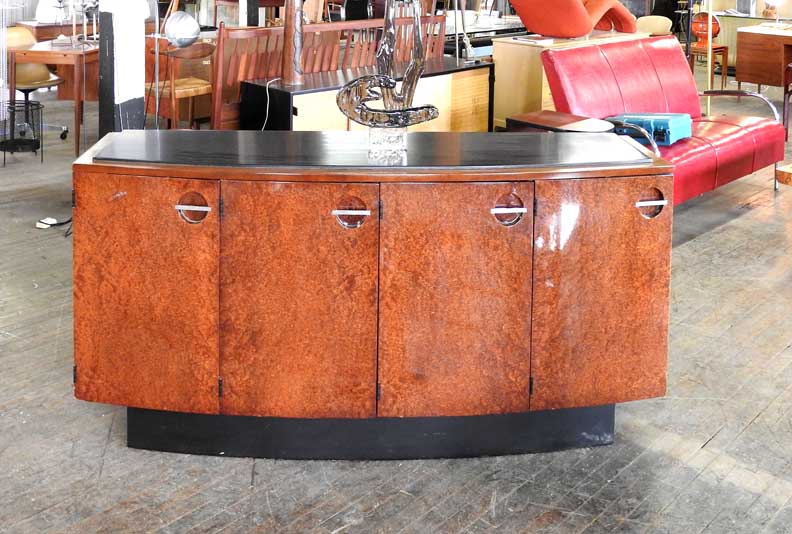 The four doors open to reveal a whopping 13 shelves. The dimensions are 72" W x 21" D x 33" H.
Same model for sale on Feb. 3, 2017 for $6,500.00 on 1stDibs. |
Original chair designed for the Mary Seaton Room in Kleinhans Music Hall 1940  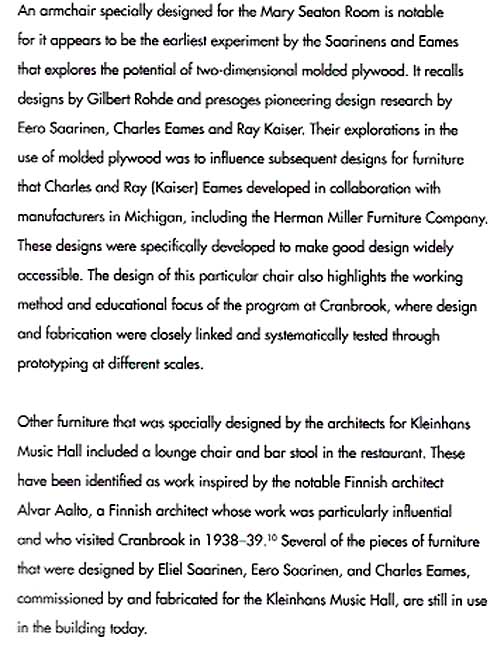 Brian Carter, Kleinhans Music Hall. Pub. by the School of Architecture and Planning, University of Buffalo, SUNY, 2013, Pp. 42, 44 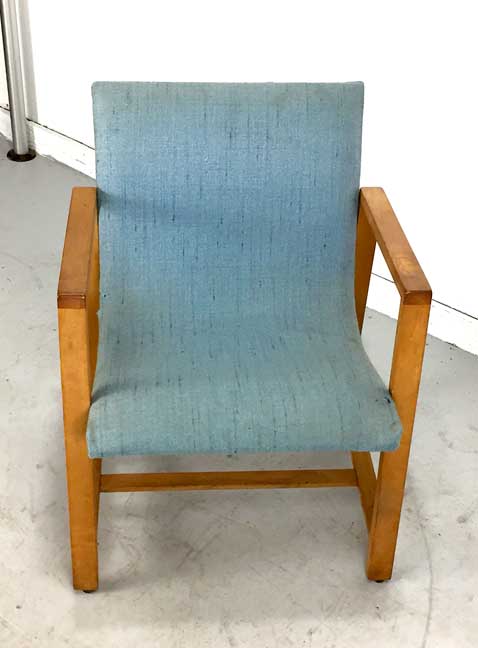 Reupholstered by private owner 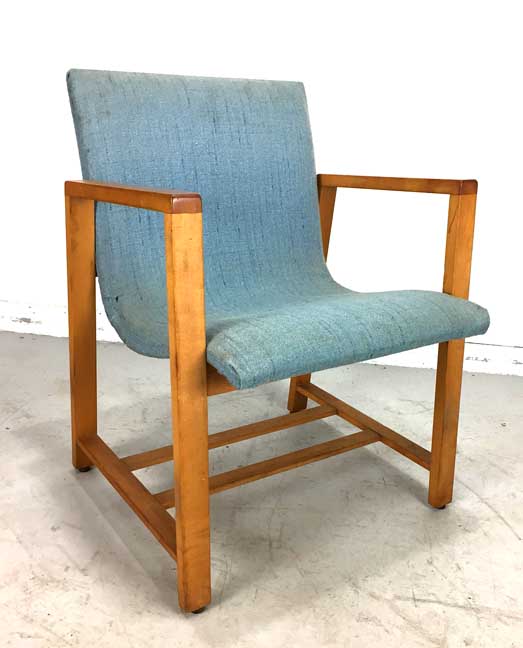 The Finnish architect and designer Eero Saarinen took over his father’s architecture firm in 1950, and famously teamed up with architect Charles Eames to co-develop the first designs for furniture made of molded laminated wood. In 1951 he designed the “Saarinen Collection” for Knoll, consisting of several office chairs, one of the designer first lines in office furniture. Defining Features: Saarinen is known for his neo-futuristic designs. His work features clean lines, bold colors, and is focused on comfort. 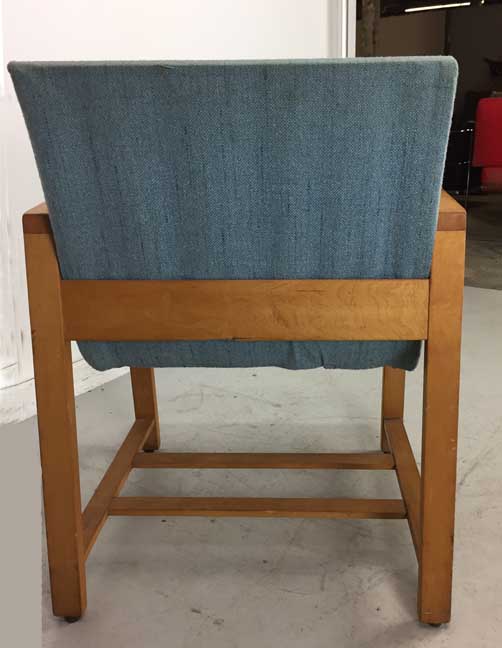 |
|
Harvey Probber Mid Century Modern Executive Desk in Herring Bone, Marble and Walnut 1950s  Source: Lobel Modern NYC (online Feb. 2017) "Harvey Probber was born in Brooklyn, New York in 1922. While attending Samuel J. Tilden High School, he took a part-time job in a used-furniture store, and was inspired to try his hand at drawing ideas for furniture. Probber sold his first sofa design when he was just 16, for $10. After high school graduation, he accepted a job as designer for Trade Upholstery, a small manufacturing facility on West 17th Street. 1940 was the beginning of American modernism, a time characterized by young designers with talent, initiative, and a willingness to take risks with new ideas. Probber was one of an early band of pioneers in a field that included D.J. DePree of Herman Miller, Hans Knoll, Georg Tanier and Jack Lenor Larsen. "Probber established Harvey Probber, Inc., in 1945. Though he considered himself a modern designer, his approach to modernity favored exotic woods, highly polished lacquer, hand-rubbed finishes and opulent upholstery fabrics - materials largely abandoned by more radical, Bauhaus-influenced designers. "Probber’s designs, like those of Edward Wormley, Tommi Parzinger, were sought after by customers who wanted modern furniture with elegance. In 1947, when showroom space wasn't available in Chicago’s Merchandise Mart, he took his line to Grand Rapids, then the center of the furniture manufacturing industry. In 1948, seeing the potential in the interior design market he opened a showroom at 136 Fifth Avenue, catering exclusively to designers. "His elastic sling chair and Nuclear upholstered groups were chosen for MoMA’s Good Design exhibition in 1951, and he won several prestigious Roscoe industry awards." - 1stDibs (online Feb. 2017) 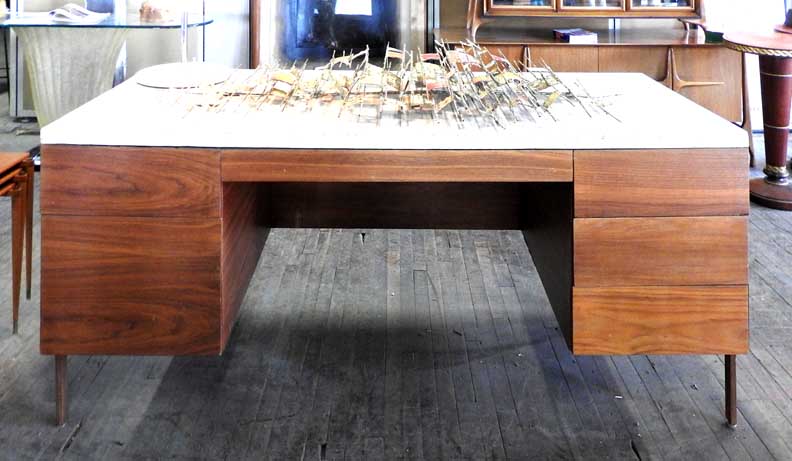 29 in. H x 72 in. W x 36 in. D Sleek simple elegant design ... 2" thick marble top with herring bone design ... Walnut case ... Wrapped rosewood over steel legs tenened through case ... Obscure drawer pulls adds to the opulent design |
Special thanks to CooCooU27 owner Michael Merisola for his cooperation and assistance in 2017.
Photos and their arrangement © 2017 Chuck LaChiusa
| ...Home Page ...| ..Buffalo Architecture Index...| ..Buffalo History Index... .|....E-Mail ...| ..